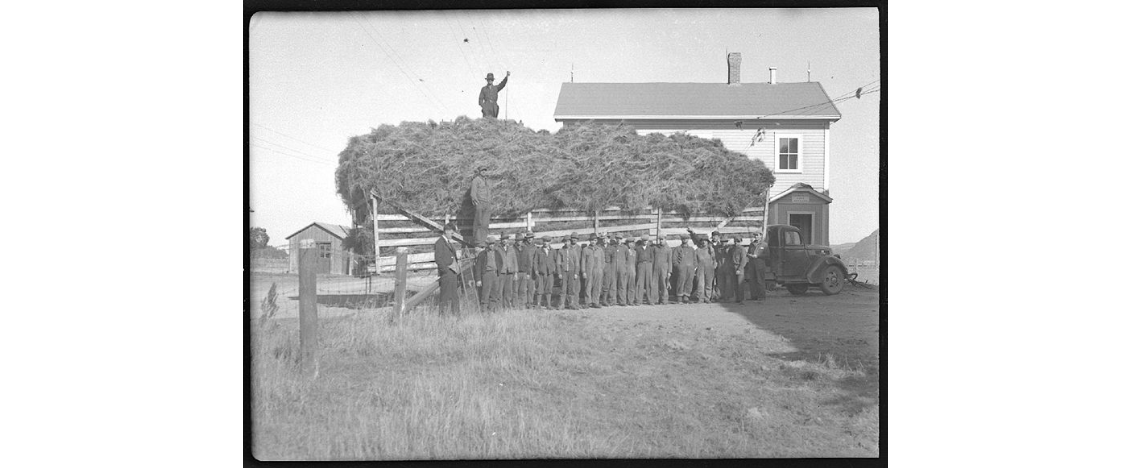I drive my shovel firmly into the soft spring soil. The mosquitoes haven’t come out yet, a light northeasterly wind is blowing, but you can feel the sun’s rays growing stronger and more confident with each passing day. Véronique approaches and hands me a small packet, her hand covered in dirt.
"Here, these are the seeds I told you about. Shall we give it a try? Come on, I could transform it by the end of the summer."
"And then what? Make us a nice blanket?"
Véronique is passionate about dyeing, weaving materials, and raw fibers. She shears sheep and talks our ears off about her experiments with onion-skin dyes on the wool she gathers from her beloved flock. This time, I take a look at her latest obsession—flax. I’ve never grown flax before; I don’t even know what it looks like. But seeing Véronique’s enthusiasm, I don’t really have much choice but to jump into the experiment with her.
Back in our ancestors’ time, flax was one of the most commonly used materials for making clothes. While winter wardrobes were made of wool—stockings, shirts, skirts, trousers, hats, and mittens—clothing for the milder seasons was made of linen.
It was also used for sheets, pillowcases, dish towels, tablecloths, napkins, and even grain or flour sacks. The plant’s fibers were used in shoemaking, and the coarse fibers were used to caulk windows and even ships!
Through my reading, I learned that the flax Véronique brought us was intended solely for fabric production, though we could have eaten its seeds, as the birds so often demonstrate.
Cultivated flax (Linum usitatissimum) falls into two categories: oilseed flax, whose seeds we consume, and textile flax, which, as the name suggests, is used to make fabric. It’s the stem’s fiber that is used.
Inhabitants, particularly those in the Quebec region, once widely cultivated flax. In 1749, Pehr Kalm noted that it was sown everywhere! In the 19th century, when everything was expensive and people couldn’t afford to buy manufactured fabrics from England, they grew even more flax.
PROVENCHER J. (1996). Les Quatre Saisons dans la vallée du St-Laurent. Éditions Boréal, Montréal, P.339
Flax Through Quebec’s Seasons
Geneviève, listening to our conversation while never stopping her shoveling, chimes in:
"Yeah, in Quebec, flax used to grow everywhere! There’s even some kind of flax museum… and an exhibit in Portneuf. They told the history of flax there, and I remember an expression they mentioned: Apparently, when a man wanted to marry, he would ask his sweetheart:
'Do you want to wear out a linen sheet with me?'"
Véronique: "I’m not sure I get it…"
Geneviève: "Well, since linen sheets were very durable, it meant wanting to spend a lifetime together."
Véronique: "That’s so cuuuuute!"
Me: "Ah, if I’d known, I wouldn’t have used cotton sheets—it might have saved me from a divorce. Alright, let’s get to work!"
Apparently, Quebec flax was coarser than European flax, but its durability was remarkable. Still, we never won any competitions against the Old World for the finesse of our flax. Unlike European women, who spent their entire year in factories refining their linen-weaving techniques, our ancestors only had winter to work on it—because the rest of the time, their 14 children, 13 goats, and 12 cows took up all their attention. And probably a few green mice, too.
That’s why the linen they wove was rougher, as evidenced by this historical account:
*"New summer sheets were stiff and scratchy. It was customary for boys to sleep in the new sheets first, since their long underwear protected them from potential scratches. As for pillowcases, they were made from old sheets—new fabric would have irritated the face.
Baby clothes, especially diapers, were sewn from the best parts of old towels or sheets. New fabrics were too rough and stiff; they would have hurt the baby’s delicate skin.*"
Not exactly appealing for 21st-century city dwellers ordering sheets from Amazon.
Here’s another little anecdote I came across in my reading:
Much later, during the time of the Patriotes, people would swap their red woolen tuques for linen ones in the summer. Lighter, they protected the head from the sun’s rays and kept hair clean.
Yet again, linen never became a strong symbol in our culture—red wool did.
Growing Flax
For details on flax cultivation conditions, refer hereito the section on flax growing. But let’s move ahead in time, since our focus is on the plant already reaching toward the sun…
By mid-July, we were all gathered around the plot where our tiny flax seeds had sprouted. Usually, five or six weeks after emerging from the soil, flax starts to flower.
If the flowers are blue, the variety comes from Riga, on the Baltic Sea; if they’re white, it’s a variety from Belgium. The old long-stemmed Canadian flax, likely brought from France, also had white flowers but was reportedly very rare by 1865.
Clearly, our flax was quite European, with its beautiful blue flowers—but not at all Quebecois. So where had our grandmothers’ flax seeds gone?
Summer stretched on, and the flax grew into tall sheaves over a meter high. Then one autumn day, Véronique arrived, pulled up all the flax, and laid it in heaps on the ground to rott.
How Was Flax Harvested?
Flax is pulled up by hand to preserve the full length of its fiber, ensuring its strength. Then comes retting, an essential fermentation process for fiber processing. The flax is spread in a thin layer on the grass for about a month. The sun and rain do the rest. Once ready, it is stored.
"When harvest time comes, the whole family lends a hand, as it takes one person 90 hours to pull and spread an acre of flax by hand."
PROVENCHER J. (1996). Les Quatre Saisons dans la vallée du St-Laurent. Éditions Boréal, Montréal, P.340.
Quebec’s Long Winters
After this stage, the sheaves are dried over a fire. Then they are broken to separate the woody part of the stalk from the fiber. This step is labor-intensive and involves multiple processes.
Next comes scutching, done with a wooden board and knife. The fibers are then combed to make them smooth and aligned. Spinners take over, stretching and twisting the flax fibers into continuous thread, ready for use.
(Annie Labrecque, Bibliothèque et Archives Nationales du Québec)
The Decline of Flax
It used to take two years from seed planting to finished clothing. Weaving was only done in winter, after many steps. Today, flax cultivation and harvesting are mechanized. Bleaching is done quickly in factories with chemicals. Weaving and clothing production are also much faster—and outsourced.
Then, in the 1950s, centuries of flax cultivation suddenly ended, swept away by a cheap fiber from India—cotton.
After this experiment, Véronique and I set out to find Quebec’s textile flax. We were shocked to find none. When we learned that flax seeds have a very short viability—just two years—it became clear why flax disappeared so quickly after being abandoned.
Over the next two years, we built connections and found some still-viable flax varieties in Europe, the U.S., and among private collectors in Quebec. Unable to ensure their survival alone, we decided to create the Citizen Program for the Preservation of Textile Flax.
By clicking here, you can join us in preserving textile flax!
If you have any information about textile flax, reach out!
To learn more...
PROVENCHER J. (1996). Les Quatre Saisons dans la vallée du St-Laurent. Éditions Boréal, Montréal.
Biennale du lin de Portneuf : https://biennaledulin.com/
La semaine verte https://ici.radio-canada.ca/actualite/semaineverte/020707/culturelin.html
CARUFEL, Hélène de, Le lin, Montréal, Léméac, 1980
Photo E.L. Desilet Séchage du lin chez la famille Babin en Gaspésie, bibliothèque et Archives du Québec 1948
Linerie de louiseville 1948
Charge de lin à ste anne de La pocatière august Scott 1942 Fond ministère de la culture et des communications
https://leplacoteux.com/lin-culture-dominante-kamouraska-300-ans/

